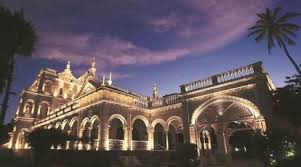Aga Khan Palace: A Beacon of India’s Struggle for Independence and Architectural Elegance
Nestled in the bustling city of Pune, Maharashtra, the Aga Khan Palace stands as a symbol of India’s rich historical tapestry and architectural grandeur. This majestic edifice, with its sweeping lawns and serene surroundings, is not just a visual delight but also a monument of immense historical significance. Let’s explore the multifaceted legacy of the Aga Khan Palace, its architectural splendor, and its role in India’s fight for independence.
Architectural Marvel
Built in 1892 by Sultan Muhammad Shah Aga Khan III, the Aga Khan Palace is a testament to the Indo-Saracenic style of architecture. The palace spans over 19 acres, with a sprawling garden that enhances its aesthetic appeal. The structure itself is a blend of Italian arches, spacious lawns, and a series of intricate hallways, reflecting the opulence and elegance of its time.
The palace is constructed with a mix of Indian and European architectural elements. Its arches, wide verandas, and expansive corridors are reminiscent of colonial architecture, while the intricately carved wooden doors and the Jali (lattice) work exhibit traditional Indian craftsmanship. The majestic facade, combined with the lush greenery surrounding the palace, creates an aura of timeless beauty.
Historical Significance
While the Aga Khan Palace is renowned for its architectural brilliance, it holds an even greater place in the annals of Indian history. During the Indian freedom struggle, this palace became a pivotal site of political imprisonment. Following the launch of the Quit India Movement in 1942, Mahatma Gandhi, his wife Kasturba Gandhi, and several other prominent leaders of the Indian National Congress were detained here by the British authorities.
The palace served as a prison for these leaders for nearly two years. Tragically, it was within these walls that Kasturba Gandhi and Mahadev Desai, Gandhi’s close aide, passed away. Their rooms have been preserved as a museum, housing their personal belongings, letters, and photographs, providing a poignant glimpse into their lives and sacrifices.
A Museum of Freedom
Today, the Aga Khan Palace functions as a museum and a memorial dedicated to Mahatma Gandhi and his ideals. The museum exhibits a vast collection of memorabilia related to Gandhi, including his personal items such as utensils, clothes, and footwear. The room where Kasturba Gandhi spent her last days remains intact, serving as a solemn reminder of the sacrifices made during the struggle for independence.
Visitors to the museum can also see a series of photographs that chronicle key moments in Gandhi’s life, his interactions with global leaders, and his various campaigns for social justice and freedom. The palace also houses the ashes of Mahatma Gandhi, preserved in a memorial within the grounds, symbolizing his enduring legacy.
Cultural and Educational Hub
Beyond its historical and architectural significance, the Aga Khan Palace is also a cultural and educational hub. It hosts various events, seminars, and exhibitions that promote Gandhian philosophy and values. The serene environment of the palace makes it an ideal setting for meditation and reflection, attracting scholars, historians, and peace enthusiasts from around the world.
The palace’s gardens, with their meticulously maintained lawns and blooming flowers, provide a tranquil escape from the city’s hustle and bustle. It’s a place where history and nature coexist harmoniously, offering visitors a space to learn, reflect, and find inspiration.
Preservation and Legacy
The Aga Khan Palace is maintained by the Archaeological Survey of India (ASI) and continues to be a site of national importance. Efforts are consistently made to preserve its structural integrity and historical artifacts, ensuring that this monument remains a source of inspiration for future generations.
Conclusion: A Living Monument of India’s Heritage
The Aga Khan Palace stands as a beacon of India’s rich heritage, embodying both its architectural splendor and historical significance. It tells the story of India’s struggle for freedom, the resilience of its leaders, and the enduring legacy of Mahatma Gandhi. Visiting the palace is not just an exploration of the past; it is a journey through the ideals that shaped a nation.
For those who wish to delve into India’s history, admire architectural beauty, or simply seek a moment of tranquility, the Aga Khan Palace offers an experience that is both enriching and enlightening. It remains a proud testament to India’s journey towards independence and a symbol of the timeless values of peace, resilience, and unity.






























































https://derivative.ca/user/624301
https://teratail.com/users/pcityhyderabado
https://www.ehx.com/users/pcityhyderabadh/
https://www.balatarin.com/users/pcityhyderabadg
https://msfn.org/board/profile/441110-prestigecityhyderabado/
https://forge.chapril.org/prestigecityhyderabadj
https://participez.villeurbanne.fr/profiles/prestigecityhyderaba/activity
https://participez.nanterre.fr/profiles/pcityhyderabadg/activity
https://community.consumeradvocates.org/network/members/profile?UserKey=62ba3003-ab55-43cb-ac14-018fb860d8ca